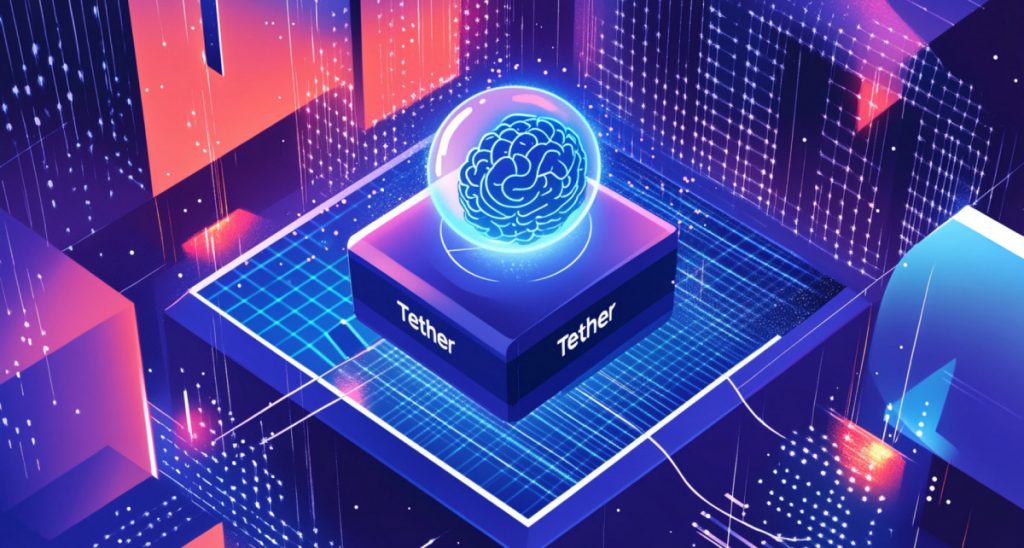Tether AI Introduces Offline Intelligence With Built-In Crypto Tools


In Brief
Tether is developing a privacy-focused AI system that runs locally on users’ devices, supports Bitcoin and USDT payments, operates offline without cloud servers or API keys, and integrates with its peer-to-peer apps like Keet.

Tether Limited, the issuer of the USDT stablecoin, is developing an AI system that can run without the internet or central servers.. Instead of sending requests to a cloud service, Tether AI is made to work directly on your computer, phone, or even smaller devices. This means people can use AI without relying on a big company or cloud provider.
Most current AI tools need API keys and server access. Tether AI removes all of that. The system runs peer-to-peer, meaning it connects from one user’s device to another without going through a company’s servers. There’s no need to create an account or get permission to use it.
Tether calls this setup “modular,” which means developers can choose what parts they want to include or remove, depending on the device or task. This gives people more freedom to run AI their own way — whether it’s something simple or more advanced.
According to Paolo Ardoino, Tether’s CEO and CTO, the goal is to allow smart tools to run anywhere and stay private. He said the current model of centralized AI collects too much personal information.
This also helps reduce the risk of leaks or mass data collection. Since all actions happen on the user’s device, there’s no external log of what the AI processes. In sensitive cases — like health, legal, or financial tasks — this setup may give people the confidence to use AI without fear of exposure. Tether believes this shift could make AI more useful for professionals, researchers, and everyday users who care about privacy.
Tether AI: No APIs, No Cloud — A Local System That Works by Itself
Tether AI is built to run without any connection to cloud platforms. This means it doesn’t rely on companies like OpenAI or Google. Instead, the AI is installed and used on the user’s own device. This helps protect sensitive information, since it never leaves the device or gets sent to outside servers.
There is also no need for API keys — a common way cloud services limit access. With Tether AI, everything works locally and without external approval. This makes it easier to build AI tools that don’t depend on subscriptions, internet access, or third-party services.
A key part of this system is the Wallet Development Kit (WDK), which lets developers add crypto features to their apps. With WDK, AI tools can send and receive payments in Bitcoin and USDT directly. This means an AI program could pay for services, accept funds, or handle wallet tasks — all without human help.
The wallets are self-custodial, so the user controls the keys. That means no one else can move the funds or see what the AI is doing. AI agents can manage these wallets securely and act independently when needed. They don’t need approval from a server or company.
Tether’s WDK works on phones, desktops, and web apps. Developers can choose how to use it — either as a full-feature wallet or just a simple tool for sending payments. This flexibility allows AI to do more than just think — it can act, spend, and interact with crypto in real time.
Connected With Keet and Pear: A Wider System for Private AI Use
Tether isn’t building this system from scratch. It already has other tools like Keet, a private chat app, and Pear, a system for making peer-to-peer programs. Tether AI is designed to work closely with both.
This means users can create AI tools that talk to each other directly — without a central service watching or storing their conversations. For example, someone could build an AI that sends private messages through Keet, or creates group chats where AI agents join and help answer questions.
Other possible uses include:
- A voice-controlled app that works offline;
- A small bot that helps manage Bitcoin or USDT transactions;
- A local assistant that translates messages instantly, without sending them to the cloud.
Because the system works without central servers, it’s also more resistant to censorship or internet blocks. The AI doesn’t need to call home to function. It can stay active, make decisions, and help users even without a strong network connection.
Tether’s aim is to create tools that live on your device and talk only to the people or apps you choose — not to remote servers owned by tech giants.
Why Tether Thinks Offline AI Could Be the Future
While most companies build AI tools that depend on online systems, Tether is betting on a different path. The company sees value in building tools that are private, self-owned, and not tied to one provider. Their financial strength helps make this possible.
In early 2025, Tether reported $1 billion in operating profit — much of it from interest on U.S. Treasury holdings. With over $149 billion in total reserves and $5.6 billion in extra capital, the company can afford to invest in long-term projects like Tether AI.
Tether doesn’t plan to make money from this AI directly. It’s not selling access or locking it behind a paid system. Instead, the platform is being released as open-source, letting anyone use it freely. The goal is to give developers and users full control — and remove the need for centralized services in the future.
Some early examples already exist. One demo shows a voice assistant that can manage a Bitcoin wallet. Another helps users complete crypto tasks like sending money or signing a contract — all from a local app. These tools are simple, but they prove that smart systems can run without the cloud.
Paolo Ardoino has also shared that Tether AI could be used in more areas — like cities, devices, or places with limited internet. Since the AI doesn’t need constant online access, it can live on machines at the edge — in homes, factories, or even in remote locations.
Tether sees this as more than a product. It’s part of a shift toward systems that don’t depend on permission or access from others. Instead of asking a company to use AI, you just run it yourself — with tools you fully own.
Disclaimer
In line with the Trust Project guidelines, please note that the information provided on this page is not intended to be and should not be interpreted as legal, tax, investment, financial, or any other form of advice. It is important to only invest what you can afford to lose and to seek independent financial advice if you have any doubts. For further information, we suggest referring to the terms and conditions as well as the help and support pages provided by the issuer or advertiser. MetaversePost is committed to accurate, unbiased reporting, but market conditions are subject to change without notice.
About The Author
Alisa, a dedicated journalist at the MPost, specializes in cryptocurrency, zero-knowledge proofs, investments, and the expansive realm of Web3. With a keen eye for emerging trends and technologies, she delivers comprehensive coverage to inform and engage readers in the ever-evolving landscape of digital finance.
More articles

Alisa, a dedicated journalist at the MPost, specializes in cryptocurrency, zero-knowledge proofs, investments, and the expansive realm of Web3. With a keen eye for emerging trends and technologies, she delivers comprehensive coverage to inform and engage readers in the ever-evolving landscape of digital finance.


















































